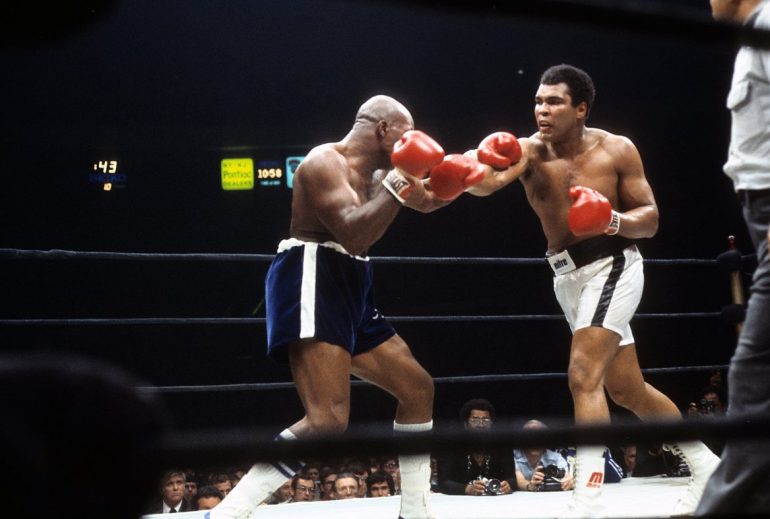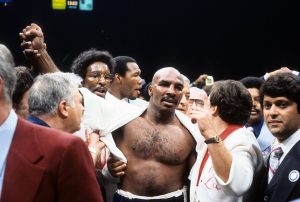Muhammad Ali-Earnie Shavers – The Last Stand 40 Years On

In 1977 Muhammad Ali was still the undisputed heavyweight champion of the world but he was no longer a great fighter.
The blindingly quick Cassius Clay who sliced up Sonny Liston in Miami was a wonder of the pugilistic past. Even the great Ali who outsmarted George Foreman and outlasted Joe Frazier in Manila a couple of years earlier could not be resurrected.
Now 35 years old, “The Greatest” was on a steep descent. In September 1976, Ali was very lucky to retain his title on points in a third fight with Ken Norton and had pondered retirement. However, the allure of multi-million-dollar paydays and an addiction to the limelight brought him back.
Alfredo Evangelista (14-1-1, 10 knockouts) was considered a safe option. The unheralded Spaniard had been a professional for less than two years and was coming off an eight-round decision loss to Italian heavyweight champion Lorenzo Zanon. Frankly speaking, Evangelista was useless.
The only thing more embarrassing than the fight being sanctioned for May 16, 1977, in Landover, Maryland, is the fact that is was competitive.
Ali missed the target over and over. Not just combinations; even the jab lacked accuracy. The dancing feet were soon replaced by a tired parody of the rope-a-dope, and Ali either feigned being exhausted or intimated that he was draining the challenger of energy. The crowd booed and ABC’s legendary commentator Howard Cosell labelled the bout “terrible.” He wasn’t wrong.
The champion retained his title by 15-round unanimous decision but it was one of the worst performances of his career.
 Next up for Ali was Earnie Shavers who was as dangerous as Evangelista was inept. Born in Garland, Alabama, and now fighting out of Warren, Ohio, the 32-year-old challenger was widely considered to be the biggest puncher in boxing. His record at the time was an incredible (54-5-1, 52 KOs).
Next up for Ali was Earnie Shavers who was as dangerous as Evangelista was inept. Born in Garland, Alabama, and now fighting out of Warren, Ohio, the 32-year-old challenger was widely considered to be the biggest puncher in boxing. His record at the time was an incredible (54-5-1, 52 KOs).
Vulnerable to a direct hit himself, Shavers had blown hot and cold in his career. Sensational knockout wins over Jimmy Young (TKO 3), Jimmy Ellis (KO 1) and Roy Williams (KO 10) were overshadowed by stoppage defeats to Ron Stander (KO 5), Jerry Quarry (TKO 1) and Ron Lyle (TKO 6).
The Ali fight was scheduled for September 29, 1977, at Madison Square Garden in New York. The champion was installed as a heavy favorite but people around him were concerned.
“I spoke to Ali just prior to the Shavers fight and implored him to quit,” said Hall of Fame sports journalist Jerry Izenberg. “I went over to see him with two video tapes. One was a show we did prior to the Foreman fight and Ali was in magnificent form; funny and articulate. The other was a commercial for a bug spray called Raid and I watched it over and over because I couldn’t make out the word ‘fog’. I played both those tapes for Ali and asked him if he could see a difference (in his speech). He said no.
“I then spoke to Ali about a pathologist named (Dr. Harrison Stanford) Martland. In the 1920s, Martland conducted autopsies on twenty dead fighters in New Jersey and from those results the term punch-drunk (pugilistic dementia) was derived. I said, ‘Muhammad, according to Martland, if you stop fighting today the damage will continue for a couple of years and then stop. However, if you continue it will start up again and progress from where it left off’. He said to me, ‘I don’t know anything about that. Why don’t you come up to Deer Lake (training camp) and we’ll talk about it?’ I knew that he wasn’t paying attention to me.”
On fight night, Ali was in boisterous mood. He taunted Shavers during the referee’s instructions and flashed jabs within millimeters of his face. Then it was time for serious business.
Ali knew Shavers was potentially lethal. There was nothing to fear in terms of boxing skill but “The Acorn,” as Ali dubbed him, could take you out with a single shot from either hand. The champion took center ring immediately and jabbed off Shavers. He worked behind an exaggeratedly high guard, teased Shavers with words and released the odd flashy combination. The challenger was unimpressed and smiled.

Shavers did damage with huge power shots. Photo by THE RING
And then it happened.
In Round 2, Shavers timed Ali’s jab and sent over a crushing right hand to the jaw. It was a knockout shot, the definition of a “go home punch,” but Ali somehow survived it. Badly hurt, he invited Shavers in and the challenger obliged. Three more vicious right hands landed flush on the champion’s jaw before the session ended. It was one of the worst rounds of Ali’s career.
The Ali-Shavers fight was the first heavyweight championship bout to utilize open scoring. The match was aired live on NBC, which displayed the official tallies between rounds. Angelo Dundee, Ali’s trainer, had an assistant who was watching the telecast in the dressing room and he would convey the scores to Dundee via hand signals from the back of the arena.
Ali boxed smart at times but he also absorbed ludicrous amounts of punishment. At the end of the 14th round, exhausted and damaged, the champion almost limped back to his corner. On the upside, he was ahead 8-6, 8-6 and 8-5-1 on the cards. Ali only needed to survive the final round to retain his title. But he saved the best for last.
“Going into the final round, I had that fight even and Ali needed a big finish in my view,” recalled Izenberg. “He fought a terrific closing round and hurt Shavers. But Ali told me there were times where he was unconscious on his feet. If you go back two or three years, Shavers couldn’t have hit Muhammad on the ass with a shovel.
“You saw in the Shavers fight that Ali had gone backwards because he got hit so much. Rarely did Earnie hit anyone below the neck; he was a headhunter and a good one. For me, Shavers was the greatest one-punch hitter I ever seen. When he floored Larry Holmes (in the second fight) I thought Holmes was dead.”
Holmes, a top contender in 1977, took on Shavers six months after the Ali fight. He boxed brilliantly, schooling the veteran over 12 rounds to a shutout decision. In the seventh round of their rematch, which took place in September 1979, when Holmes was champion, Shavers finally caught “The Easton Assassin” with a bomb.
“I only let Earnie catch me once in two fights and I was like, ‘No way is this guy hitting me again,’” laughed Holmes. “I saw white lights and everything. I went to throw a right uppercut and he came over with a damn right hand. He knocked me out with that punch and I woke up when I hit the floor. If he didn’t hit me so damn hard, I’d have stayed down.
“I knew how hard Earnie hit because I was his sparring partner. He hurt people in the gym and ended up having to spar with 18 ounce gloves on or nobody would box him. I had to box him because I wanted the job … but I ran.”
Earlier this year, Holmes told me that, in his opinion, the Shavers fight contributed massively to Ali’s subsequent health problems. One thing is for sure: It didn’t help.

Shavers thought he’d done enough to win. Photo by THE RING
Dr. Ferdie Pacheco, Ali’s personal physician for 15 years, had seen enough after that brutal night in New York. After receiving results from a battery of tests Ali had submitted to following the Shavers fight, Pacheco wrote letters to Ali’s wife Veronica, his manager Herbert Muhammad and Angelo Dundee. Despite the mounting damage, Pacheco insists that he did not receive one response.
“Dr. Guardino came to me and discussed Ali’s lab work. His face was serious,” writes Pacheco in his 1992 book “Muhammad Ali – A View from the Corner.” “The urine exam not only revealed blood in the urine, but entire sections of cells from the tubules. These cells filter the blood. They are not replaceable. They scar and impair kidney function. It is a serious finding, indicating impending kidney damage which could lead to grim consequences later in life.”
“The Greatest” would fight four more times and win only once. He lost to Leon Spinks in February 1978 before avenging that defeat seven months later in New Orleans. He retired as the only three-time heavyweight champion of the world but comebacks, like the roar of the crowd, had become an addiction. In October 1980, an almost passive Ali was stopped by Holmes in 10 rounds and a points defeat to Trevor Berbick signaled the end of arguably the most glorious career in sports on December 11, 1981.
Ali’s health declined quite rapidly and he was diagnosed with Parkinson’s Syndrome in 1984.
Shavers fought until he was 50 years old with mixed success. He never won a world title but he came damn close, shaking up two of the best heavyweight champions of all time.
Tom Gray is a UK Correspondent/ Editor for RingTV.com and a member of THE RING ratings panel. Follow him on Twitter: @Tom_Gray_Boxing















